MENU
The Electronic Scholarly Publishing Project: Providing access to classic scientific papers and other scholarly materials, since 1993. More About: ESP | OUR CONTENT | THIS WEBSITE | WHAT'S NEW | WHAT'S HOT
Comparative Timelines
The ESP Timeline (one of the site's most popular features) has been completely updated to allow the user to select (using the timeline controls above each column) different topics for the left and right sides of the display.
Select:
New Left Column
New Left Column
Dates
Decade
New Right Column
New Right Column
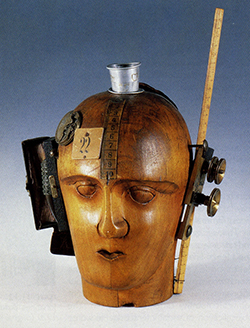 Sculpture by Raoul Hausmann: Mechanischer Kopf (Der Geist Unserer Zeit) — "The Mechanical Head (The Spirit of Our Time)" is the only surviving assemblage that Hausmann produced around 1919-20. Constructed from a hairdresser's wig-making dummy, the piece has various measuring devices attached including a ruler, a pocket watch mechanism, a typewriter, some camera segments and a crocodile wallet. "Der Geist Unserer Zeit — Mechanischer Kopf specifically evokes the philosopher George Wilhelm Friedrich Hegel. For Hegel...everything is mind. Among Hegel's disciples and critics was Karl Marx. Hausmann's sculpture might be seen as an aggressively Marxist reversal of Hegel: this is a head whose "thoughts" are materially determined by objects literally fixed to it. However, there are deeper targets in western culture that give this modern masterpiece its force. Hausmann turns inside out the notion of the head as seat of reason, an assumption that lies behind the European fascination with the portrait. He reveals a head that is penetrated and governed by brute external forces.
Sculpture by Raoul Hausmann: Mechanischer Kopf (Der Geist Unserer Zeit) — "The Mechanical Head (The Spirit of Our Time)" is the only surviving assemblage that Hausmann produced around 1919-20. Constructed from a hairdresser's wig-making dummy, the piece has various measuring devices attached including a ruler, a pocket watch mechanism, a typewriter, some camera segments and a crocodile wallet. "Der Geist Unserer Zeit — Mechanischer Kopf specifically evokes the philosopher George Wilhelm Friedrich Hegel. For Hegel...everything is mind. Among Hegel's disciples and critics was Karl Marx. Hausmann's sculpture might be seen as an aggressively Marxist reversal of Hegel: this is a head whose "thoughts" are materially determined by objects literally fixed to it. However, there are deeper targets in western culture that give this modern masterpiece its force. Hausmann turns inside out the notion of the head as seat of reason, an assumption that lies behind the European fascination with the portrait. He reveals a head that is penetrated and governed by brute external forces.
1920
(no entry for this year)
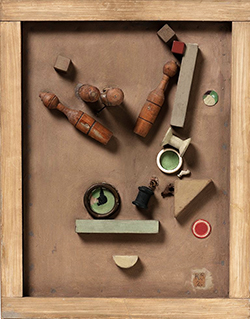 Assemblage by Kurt Schwitters: Merzpicture 46A. The Skittle Picture — an early example of Schitters' assemblages in which two and three dimensional objects are combined. The word "Merz," which Schwitters used to describe his art practice as well as his individual pieces, is a nonsensical word, like Dada, that Schwitters culled from the word "commerz", the meaning of which he described as follows: "In the war, things were in terrible turmoil. What I had learned at the academy was of no use to me.... Everything had broken down and new things had to be made out of the fragments; and this is Merz". In his Merzpictures, which have been called "psychological collages," he arranged found objects — usually detritus — in simple compositions that transformed trash into beautiful works of art. Whether the materials were string, a ticket stub, or a chess piece, Schwitters considered them to be equal with any traditional art material. Merz, however, is not ideological, dogmatic, hostile, or political as is much of Dada art.
Assemblage by Kurt Schwitters: Merzpicture 46A. The Skittle Picture — an early example of Schitters' assemblages in which two and three dimensional objects are combined. The word "Merz," which Schwitters used to describe his art practice as well as his individual pieces, is a nonsensical word, like Dada, that Schwitters culled from the word "commerz", the meaning of which he described as follows: "In the war, things were in terrible turmoil. What I had learned at the academy was of no use to me.... Everything had broken down and new things had to be made out of the fragments; and this is Merz". In his Merzpictures, which have been called "psychological collages," he arranged found objects — usually detritus — in simple compositions that transformed trash into beautiful works of art. Whether the materials were string, a ticket stub, or a chess piece, Schwitters considered them to be equal with any traditional art material. Merz, however, is not ideological, dogmatic, hostile, or political as is much of Dada art.
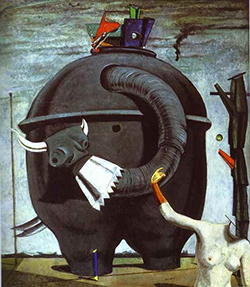 Painting by Max Ernst: The Elephant Celebes (or short Celebes) is among the most famous of Ernst's early surrealist works and "undoubtedly the first masterpiece of Surrealist painting in the de Chirico tradition." It combines the vivid dreamlike atmosphere of Surrealism with the collage aspects of Dada. The painting attempts to apply Dada's collage effects to simulate different materials. Ernst's realistic portrayal of the constituent elements produces a hallucinatory effect that he associated with collage, and was trying to achieve in this painting. Regarding the art of collage, Ernst said, "It is the systematic exploitation of the coincidental or artificially provoked encounter of two of more unrelated realities on an apparently inappropriate plane and the spark of poetry created by the proximity of these realities."
Painting by Max Ernst: The Elephant Celebes (or short Celebes) is among the most famous of Ernst's early surrealist works and "undoubtedly the first masterpiece of Surrealist painting in the de Chirico tradition." It combines the vivid dreamlike atmosphere of Surrealism with the collage aspects of Dada. The painting attempts to apply Dada's collage effects to simulate different materials. Ernst's realistic portrayal of the constituent elements produces a hallucinatory effect that he associated with collage, and was trying to achieve in this painting. Regarding the art of collage, Ernst said, "It is the systematic exploitation of the coincidental or artificially provoked encounter of two of more unrelated realities on an apparently inappropriate plane and the spark of poetry created by the proximity of these realities."
1921
(no entry for this year)

 James Joyce publishes Ulysses and T. S. Eliot publishes The Wasteland, two significant works in the new literary movement called modernism.
James Joyce publishes Ulysses and T. S. Eliot publishes The Wasteland, two significant works in the new literary movement called modernism.
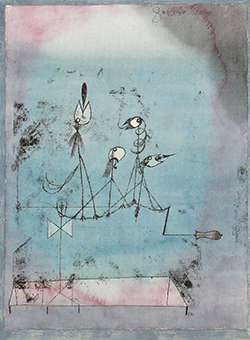 Painting by Paul Klee: Twittering Machine (Die Zwitscher-Maschine). Like other artworks by Klee, it blends biology and machinery, depicting a loosely sketched group of birds on a wire or branch connected to a hand-crank. Interpretations of the work vary widely: it has been perceived as a nightmarish lure for the viewer or a depiction of the helplessness of the artist, but also as a triumph of nature over mechanical pursuits. It has been seen as a visual representation of the mechanics of sound. Originally displayed in Germany, the image was declared "degenerate art" by Adolf Hitler in 1933 and sold by the Nazi Party to an art dealer in 1939, whence it made its way to New York. One of the better known of more than 9,000 works produced by Klee, it is among the more famous images of the New York Museum of Modern Art (MoMA). It has inspired several musical compositions and, according to a 1987 magazine profile in New York Magazine, has been a popular piece to hang in children's bedrooms.
Painting by Paul Klee: Twittering Machine (Die Zwitscher-Maschine). Like other artworks by Klee, it blends biology and machinery, depicting a loosely sketched group of birds on a wire or branch connected to a hand-crank. Interpretations of the work vary widely: it has been perceived as a nightmarish lure for the viewer or a depiction of the helplessness of the artist, but also as a triumph of nature over mechanical pursuits. It has been seen as a visual representation of the mechanics of sound. Originally displayed in Germany, the image was declared "degenerate art" by Adolf Hitler in 1933 and sold by the Nazi Party to an art dealer in 1939, whence it made its way to New York. One of the better known of more than 9,000 works produced by Klee, it is among the more famous images of the New York Museum of Modern Art (MoMA). It has inspired several musical compositions and, according to a 1987 magazine profile in New York Magazine, has been a popular piece to hang in children's bedrooms.
1922
(no entry for this year)
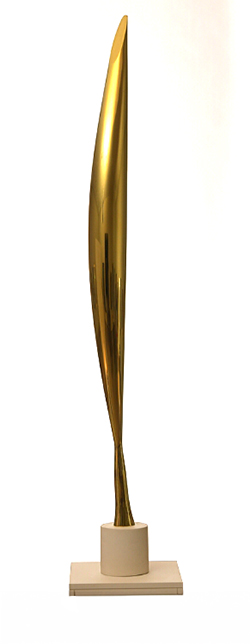 Sculpture by Constantin Brancusi: Bird in Space (L'Oiseau dans l'espace), the first in a series of sculptures. The original work was created in 1923 and made of marble. This sculpture is also known for containing seven marble figures and nine bronze casts. Brancusi created the piece over 14 times and in several mediums over a period of 20 years. It was sold in 2005 for $27.5 million, at the time a record price for a sculpture sold in an auction. In 1931, Yashwant Rao Holkar II — the young Maharaja of Indore acquired a bronze version for his Art Deco palace (Manik Bagh) in Indore. During his visit to Brancusi's studio in 1933, the Maharaja also reserved two other Birds in Space (in black marble and white, today at the National Gallery of Australia). When Brancusi shipped these to India three years later, he enclosed a note explaining, "My birds are a series of different objects based on a central theme that remains the same throughout. The ideal of its realization is to be an amplification that fills the whole vault of heaven."
Sculpture by Constantin Brancusi: Bird in Space (L'Oiseau dans l'espace), the first in a series of sculptures. The original work was created in 1923 and made of marble. This sculpture is also known for containing seven marble figures and nine bronze casts. Brancusi created the piece over 14 times and in several mediums over a period of 20 years. It was sold in 2005 for $27.5 million, at the time a record price for a sculpture sold in an auction. In 1931, Yashwant Rao Holkar II — the young Maharaja of Indore acquired a bronze version for his Art Deco palace (Manik Bagh) in Indore. During his visit to Brancusi's studio in 1933, the Maharaja also reserved two other Birds in Space (in black marble and white, today at the National Gallery of Australia). When Brancusi shipped these to India three years later, he enclosed a note explaining, "My birds are a series of different objects based on a central theme that remains the same throughout. The ideal of its realization is to be an amplification that fills the whole vault of heaven."
1923
(no entry for this year)
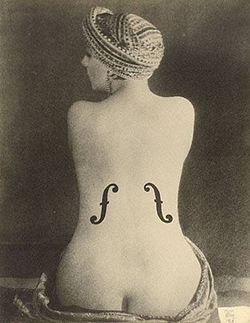 Photograph by Man Ray: Le Violon d'Ingres, a surrealistic photograph inspired by La Baigneuse Valpin on, an 1808 painting by Jean-Auguste-Dominique Ingres. The model is Alice Ernestine Prin (nicknamed Queen of Montparnasse, and often known as Kiki de Montparnasse), a French artist's model, nightclub singer, actress, memoirist, and painter. She flourished in, and helped define, the liberated culture of Paris in the 1920s. As an artist's model and Parisian sophisticate, she appeared often as the subject of paintings and sculpture.
Photograph by Man Ray: Le Violon d'Ingres, a surrealistic photograph inspired by La Baigneuse Valpin on, an 1808 painting by Jean-Auguste-Dominique Ingres. The model is Alice Ernestine Prin (nicknamed Queen of Montparnasse, and often known as Kiki de Montparnasse), a French artist's model, nightclub singer, actress, memoirist, and painter. She flourished in, and helped define, the liberated culture of Paris in the 1920s. As an artist's model and Parisian sophisticate, she appeared often as the subject of paintings and sculpture.
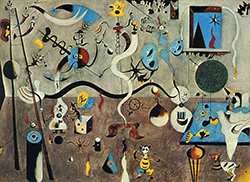 Painting by Joan Mir : The Harlequin's Carnival (Spanish: Carnaval de Arlequ n) is an oil painting rendered by Joan Mir between 1924 and 1925. It is one of the most outstanding surrealist paintings of the artist, and it is preserved in the Albright Knox Art Gallery, Buffalo. Created between 1924 and 1925, Harlequin's Carnival is one of Mir's best-known pieces. Harlequin is the name of an Italian comic theater character, generally identified by his checkered costume. The carnival in the title of the painting may refer to Mardi Gras, the celebration that occurs before the fasting of Lent begins.
Painting by Joan Mir : The Harlequin's Carnival (Spanish: Carnaval de Arlequ n) is an oil painting rendered by Joan Mir between 1924 and 1925. It is one of the most outstanding surrealist paintings of the artist, and it is preserved in the Albright Knox Art Gallery, Buffalo. Created between 1924 and 1925, Harlequin's Carnival is one of Mir's best-known pieces. Harlequin is the name of an Italian comic theater character, generally identified by his checkered costume. The carnival in the title of the painting may refer to Mardi Gras, the celebration that occurs before the fasting of Lent begins.
1924
(no entry for this year)
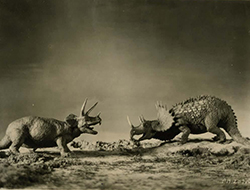 The film adaptation of Sir Arthur Conan Doyle's dinosaurs-and-cavemen fantasy The Lost World premieres.
The film adaptation of Sir Arthur Conan Doyle's dinosaurs-and-cavemen fantasy The Lost World premieres.
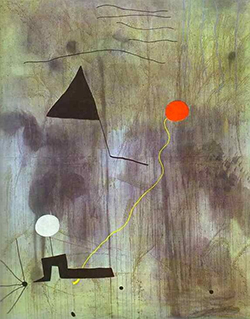 Painting by Joan JMiró: The Birth of the World depicts "a sort of genesis" — the amorphous beginnings of life. To make this work, Miró poured, brushed, and flung paint on an unevenly primed canvas so that the paint soaked in some areas and rested on top in others. Atop this relatively uncontrolled application of paint, he added lines and shapes he had previously planned in studies. The bird or kite, shooting star, balloon, and figure with white head may all seem somehow familiar, yet their association is illogical. Describing his method, Miró said, "Rather than setting out to paint something I began painting and as I paint the picture begins to assert itself, or suggest itself under my brush.... The first stage is free, unconscious." — like other Surrealists, Miró derived much inspiration from psychoanalyst Sigmund Freud's theories on dreams and the workings of the subconscious mind.
Painting by Joan JMiró: The Birth of the World depicts "a sort of genesis" — the amorphous beginnings of life. To make this work, Miró poured, brushed, and flung paint on an unevenly primed canvas so that the paint soaked in some areas and rested on top in others. Atop this relatively uncontrolled application of paint, he added lines and shapes he had previously planned in studies. The bird or kite, shooting star, balloon, and figure with white head may all seem somehow familiar, yet their association is illogical. Describing his method, Miró said, "Rather than setting out to paint something I began painting and as I paint the picture begins to assert itself, or suggest itself under my brush.... The first stage is free, unconscious." — like other Surrealists, Miró derived much inspiration from psychoanalyst Sigmund Freud's theories on dreams and the workings of the subconscious mind.
1925
(no entry for this year)
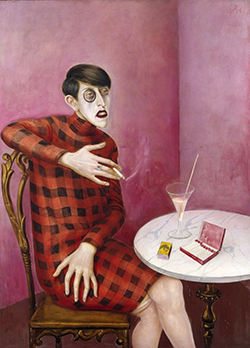 Painting by Otto Dix: "Bildnis der Journalistin Sylvia von Harden" (Portrait of the Journalist Sylvia von Harden, 1926). Sylvia von Harden was a German journalist and poet. During her career as a journalist, she wrote for many newspapers in Germany and England. An ambivalent image of the New Woman, it depicts von Harden with bobbed hair and monocle, seated at a cafe table with a cigarette in her hand and a cocktail in front of her. This painting is recreated in an opening scene of the 1972 film Cabaret. In 1959, von Harden wrote an article, "Erinnerungen an Otto Dix" ("Memories of Otto Dix"), in which she described the genesis of the portrait. Dix had met her on the street, and declared: 'I must paint you! I simply must! ... You are representative of an entire epoch!' 'So, you want to paint my lacklustre eyes, my ornate ears, my long nose, my thin lips; you want to paint my long hands, my short legs, my big feet — things which can only scare people off and delight no-one?' 'You have brilliantly characterized yourself, and all that will lead to a portrait representative of an epoch concerned not with the outward beauty of a woman but rather with her psychological condition.' The painting, an important example of the New Objectivity movement, is now in the Musée National d'Art Moderne, Centre Georges Pompidou, Paris.
Painting by Otto Dix: "Bildnis der Journalistin Sylvia von Harden" (Portrait of the Journalist Sylvia von Harden, 1926). Sylvia von Harden was a German journalist and poet. During her career as a journalist, she wrote for many newspapers in Germany and England. An ambivalent image of the New Woman, it depicts von Harden with bobbed hair and monocle, seated at a cafe table with a cigarette in her hand and a cocktail in front of her. This painting is recreated in an opening scene of the 1972 film Cabaret. In 1959, von Harden wrote an article, "Erinnerungen an Otto Dix" ("Memories of Otto Dix"), in which she described the genesis of the portrait. Dix had met her on the street, and declared: 'I must paint you! I simply must! ... You are representative of an entire epoch!' 'So, you want to paint my lacklustre eyes, my ornate ears, my long nose, my thin lips; you want to paint my long hands, my short legs, my big feet — things which can only scare people off and delight no-one?' 'You have brilliantly characterized yourself, and all that will lead to a portrait representative of an epoch concerned not with the outward beauty of a woman but rather with her psychological condition.' The painting, an important example of the New Objectivity movement, is now in the Musée National d'Art Moderne, Centre Georges Pompidou, Paris.
1926
(no entry for this year)
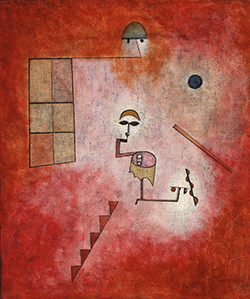 Painting by Paul Klee: Prestidigitator (Conjuring Trick). Klee's highly individual style was influenced by movements in art that included Expressionism, Cubism, and Surrealism. Klee was a natural draftsman who experimented with and eventually deeply explored color theory, writing about it extensively; his lectures Writings on Form and Design Theory (Schriften zur Form und Gestaltungslehre), published in English as the Paul Klee Notebooks, are held to be as important for modern art as Leonardo da Vinci's A Treatise on Painting for the Renaissance.
Painting by Paul Klee: Prestidigitator (Conjuring Trick). Klee's highly individual style was influenced by movements in art that included Expressionism, Cubism, and Surrealism. Klee was a natural draftsman who experimented with and eventually deeply explored color theory, writing about it extensively; his lectures Writings on Form and Design Theory (Schriften zur Form und Gestaltungslehre), published in English as the Paul Klee Notebooks, are held to be as important for modern art as Leonardo da Vinci's A Treatise on Painting for the Renaissance.
1927
(no entry for this year)
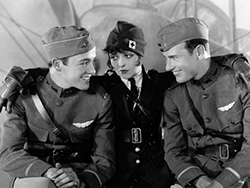 Wings wins Academy Award for best picture. The silent film about World War I soldiers and their girls back home provided intimacy and spectacle, including aviation sequences that are still impressive. For the first six ceremonies, the Academy did not use the calendar year, which is why the dates are a little confusing.
Wings wins Academy Award for best picture. The silent film about World War I soldiers and their girls back home provided intimacy and spectacle, including aviation sequences that are still impressive. For the first six ceremonies, the Academy did not use the calendar year, which is why the dates are a little confusing.
1928
(no entry for this year)
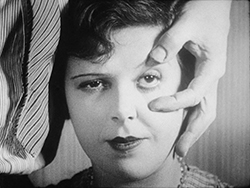 Surrealism goes to the movies, with Un Chien Andalou (An Andalusian Dog), a 1929 silent surrealist short film by the Spanish director Luis Buñuel and artist Salvador Dalí. It was Buñuel's first film and was initially released in 1929 with a limited showing at Studio des Ursulines in Paris, but became popular and ran for eight months. Un Chien Andalou has no plot in the conventional sense of the word. The chronology of the film is disjointed, jumping from the initial "once upon a time" to "eight years later" without the events or characters changing very much. It uses dream logic in narrative flow that can be described in terms of then-popular Freudian free association, presenting a series of tenuously related scenes. The idea for the film began when Buñuel was working as an assistant director for Jean Epstein in France. Buñuel told Dalí at a restaurant one day about a dream in which a cloud sliced the moon in half "like a razor blade slicing through an eye". Dalí responded that he'd dreamed about a hand crawling with ants. Excitedly, Buñuel declared: "There's the film, let's go and make it.'" They were fascinated by what the psyche could create, and decided to write a script based on the concept of suppressed human emotions. In deliberate contrast to the approach taken by Jean Epstein and his peers, which was to never leave anything in their work to chance, with every aesthetic decision having a rational explanation and fitting clearly into the whole, Bu uel made clear throughout his writings that, between Dalí and himself, the only rule for the writing of the script was: "No idea or image that might lend itself to a rational explanation of any kind would be accepted." Buñuel also stated: "Nothing, in the film, symbolizes anything. The only method of investigation of the symbols would be, perhaps, psychoanalysis."
Surrealism goes to the movies, with Un Chien Andalou (An Andalusian Dog), a 1929 silent surrealist short film by the Spanish director Luis Buñuel and artist Salvador Dalí. It was Buñuel's first film and was initially released in 1929 with a limited showing at Studio des Ursulines in Paris, but became popular and ran for eight months. Un Chien Andalou has no plot in the conventional sense of the word. The chronology of the film is disjointed, jumping from the initial "once upon a time" to "eight years later" without the events or characters changing very much. It uses dream logic in narrative flow that can be described in terms of then-popular Freudian free association, presenting a series of tenuously related scenes. The idea for the film began when Buñuel was working as an assistant director for Jean Epstein in France. Buñuel told Dalí at a restaurant one day about a dream in which a cloud sliced the moon in half "like a razor blade slicing through an eye". Dalí responded that he'd dreamed about a hand crawling with ants. Excitedly, Buñuel declared: "There's the film, let's go and make it.'" They were fascinated by what the psyche could create, and decided to write a script based on the concept of suppressed human emotions. In deliberate contrast to the approach taken by Jean Epstein and his peers, which was to never leave anything in their work to chance, with every aesthetic decision having a rational explanation and fitting clearly into the whole, Bu uel made clear throughout his writings that, between Dalí and himself, the only rule for the writing of the script was: "No idea or image that might lend itself to a rational explanation of any kind would be accepted." Buñuel also stated: "Nothing, in the film, symbolizes anything. The only method of investigation of the symbols would be, perhaps, psychoanalysis."
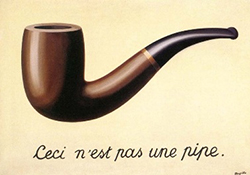 Painting by René Magritte: The Treachery of Images (French: La trahison des images, 1928–29, sometimes translated as The Treason of Images) shows a pipe. Below it, Magritte painted, "Ceci n'est pas une pipe.", French for "This is not a pipe." Magritte's comment: "The famous pipe. How people reproached me for it! And yet, could you stuff my pipe? No, it's just a representation, is it not? So if I had written on my picture 'This is a pipe', I'd have been lying!" The painting is sometimes given as an example of meta message conveyed by paralanguage. Compare with Korzybski's "The word is not the thing" and "The map is not the territory" or Freud's "Sometimes a cigar is just a cigar."
Painting by René Magritte: The Treachery of Images (French: La trahison des images, 1928–29, sometimes translated as The Treason of Images) shows a pipe. Below it, Magritte painted, "Ceci n'est pas une pipe.", French for "This is not a pipe." Magritte's comment: "The famous pipe. How people reproached me for it! And yet, could you stuff my pipe? No, it's just a representation, is it not? So if I had written on my picture 'This is a pipe', I'd have been lying!" The painting is sometimes given as an example of meta message conveyed by paralanguage. Compare with Korzybski's "The word is not the thing" and "The map is not the territory" or Freud's "Sometimes a cigar is just a cigar."
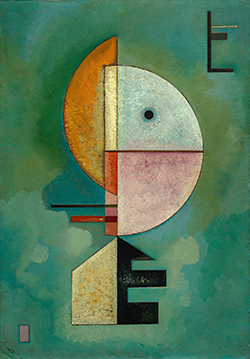 Painting by Wassily Kandinsky: Upward (Empor). Geometric abstraction, oil on cardboard.
Painting by Wassily Kandinsky: Upward (Empor). Geometric abstraction, oil on cardboard.
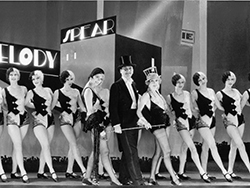 The Broadway Melody wins Academy Award for best picture. It was the first talkie to win an Oscar, with the movie's publicity bragging All talking! All dancing! All singing! That novelty made it a sensation, but the film is pretty creaky in modern times. There were no nominations that year, just an announcement of winners.
The Broadway Melody wins Academy Award for best picture. It was the first talkie to win an Oscar, with the movie's publicity bragging All talking! All dancing! All singing! That novelty made it a sensation, but the film is pretty creaky in modern times. There were no nominations that year, just an announcement of winners.
1929
(no entry for this year)
ESP Quick Facts
ESP Origins
In the early 1990's, Robert Robbins was a faculty member at Johns Hopkins, where he directed the informatics core of GDB — the human gene-mapping database of the international human genome project. To share papers with colleagues around the world, he set up a small paper-sharing section on his personal web page. This small project evolved into The Electronic Scholarly Publishing Project.
ESP Support
In 1995, Robbins became the VP/IT of the Fred Hutchinson Cancer Research Center in Seattle, WA. Soon after arriving in Seattle, Robbins secured funding, through the ELSI component of the US Human Genome Project, to create the original ESP.ORG web site, with the formal goal of providing free, world-wide access to the literature of classical genetics.
ESP Rationale
Although the methods of molecular biology can seem almost magical to the uninitiated, the original techniques of classical genetics are readily appreciated by one and all: cross individuals that differ in some inherited trait, collect all of the progeny, score their attributes, and propose mechanisms to explain the patterns of inheritance observed.
ESP Goal
In reading the early works of classical genetics, one is drawn, almost inexorably, into ever more complex models, until molecular explanations begin to seem both necessary and natural. At that point, the tools for understanding genome research are at hand. Assisting readers reach this point was the original goal of The Electronic Scholarly Publishing Project.
ESP Usage
Usage of the site grew rapidly and has remained high. Faculty began to use the site for their assigned readings. Other on-line publishers, ranging from The New York Times to Nature referenced ESP materials in their own publications. Nobel laureates (e.g., Joshua Lederberg) regularly used the site and even wrote to suggest changes and improvements.
ESP Content
When the site began, no journals were making their early content available in digital format. As a result, ESP was obliged to digitize classic literature before it could be made available. For many important papers — such as Mendel's original paper or the first genetic map — ESP had to produce entirely new typeset versions of the works, if they were to be available in a high-quality format.
ESP Help
Early support from the DOE component of the Human Genome Project was critically important for getting the ESP project on a firm foundation. Since that funding ended (nearly 20 years ago), the project has been operated as a purely volunteer effort. Anyone wishing to assist in these efforts should send an email to Robbins.
ESP Plans
With the development of methods for adding typeset side notes to PDF files, the ESP project now plans to add annotated versions of some classical papers to its holdings. We also plan to add new reference and pedagogical material. We have already started providing regularly updated, comprehensive bibliographies to the ESP.ORG site.
ESP Picks from Around the Web (updated 06 MAR 2017 )
Old Science

Weird Science

Treating Disease with Fecal Transplantation
Fossils of miniature humans (hobbits) discovered in Indonesia

Dinosaur tail, complete with feathers, found preserved in amber.
Astronomy

Mysterious fast radio burst (FRB) detected in the distant universe.